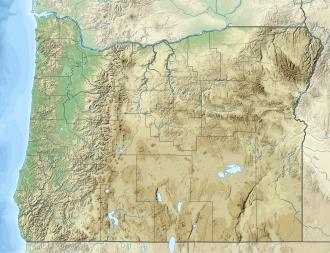Long Tom River
River in Oregon, United States From Wikipedia, the free encyclopedia
The Long Tom River is a 57-mile (92 km) tributary of the Willamette River in western Oregon in the United States.[4] It drains an area at the south end of the Willamette Valley between Eugene and Corvallis.[6]
| Long Tom River | |
|---|---|
 The Long Tom River as it appears while passing through the Oregon Country Fair's land near Veneta | |
| Etymology | Developed gradually in the 19th century in imitation of a native tribal name[1] |
| Location | |
| Country | United States |
| State | Oregon |
| County | Lane and Benton |
| Physical characteristics | |
| Source | Central Oregon Coast Range |
| • location | Long Tom Station, Lane County |
| • coordinates | 44°13′12″N 123°26′39″W[2] |
| • elevation | 1,131 ft (345 m)[3] |
| Mouth | Willamette River |
• location | Norwood Island, Benton County |
• coordinates | 44°22′48″N 123°14′54″W[2] |
• elevation | 256 ft (78 m) |
| Length | 57 mi (92 km)[4] |
| Basin size | 410 sq mi (1,100 km2)[5] |
| Discharge | |
| • average | 753 cu ft/s (21.3 m3/s)[4] |
It rises in the Central Oregon Coast Range in western Lane County, approximately 10 mi (16 km) west of Veneta. It flows east through the mountains to Veneta, through the Fern Ridge Reservoir, and then north into the Willamette Valley, roughly parallel to and west of the Willamette River. It joins the Willamette from the southwest approximately 4 mi (6.5 km) west of Halsey. The Fern Ridge Reservoir was created in 1942 when the United States Army Corps of Engineers dammed the river to control flooding.[7]
The watershed includes approximately 410 sq mi (1,100 km2) of land (262,000 acres, 1060 km2) zoned as 45 percent forest, 30 percent agricultural, 8 public, and 17 percent urban or rural residential.[5] The Long Tom waters support more than 140,000 people in the area, including residents in the city of Veneta and the rural farming communities of Alvadore, Cheshire, Crow, Franklin, and Noti, as well as industrial and commercial land on the western edge of Eugene.[8] These lands were inhabited by the Chelamela group of the Kalapuya Indians prior to European settlement.
The Oregon Country Fair is one of many groups and agencies that work with the Long Tom Watershed Council to protect and restore the river.[9]
Name
The river's name, Long Tom, developed gradually during the 19th century in imitation of a native tribal group called Lung-tum-ler.[1] The Native American name of this Kalapuyan group is [lámpʰtumpif], literally meaning "spank-his-ass".[10]
Tributaries
Named tributaries from source to mouth are Micheals, Jones, Swamp, Dusky, Hayes, Sweet, Green, and Gold creeks. Then come Noti, Wilson, Indian creeks before the river enters Fern Ridge Reservoir. Hannavan and Inman creeks enter the reservoir as does Coyote Creek. (The topographic map also shows a separate Coyote Creek that leaves the reservoir south of the main Long Tom channel and rejoins it further downstream.) Below the reservoir come Squaw, the second confluence with Coyote Creek, then Lingo Slough, Bear, Amazon, Ferguson, Shafer, and Miller creeks.[6]
See also
References
External links
Wikiwand - on
Seamless Wikipedia browsing. On steroids.

